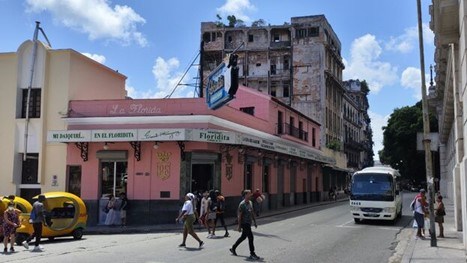
By Juan Diego Rodriguez (14ymedio)
HAVANA TIMES – Like the Hotel Ambos Mundos or the Finca Vigía, the iconic salmon-colored façade of Havana’s El Floridita, serves as a shrine to the memory of Ernest Hemingway. Anyone walking along Obispo Street, or crossing Central Park looking for the famous restaurant, founded in 1812, will find it. However, what they will see flanking it are dilapidated buildings whose potential collapse threatens not only the “birthplace of the daiquiri” but also the hundreds of Havana residents who ponder the possibility of the buildings’ demise every day .
Havana’s historic heart is falling apart and many buildings, abandoned or on the verge of being abandoned, are like grotesque doll houses. Vines and ferns grow between every balcony while a skeleton of pipes and rebars barely manage to hold the structure in place.
Sweaty and in a hurry are the few tourists who come here. Before entering Floridita, they take note of the flimsy balconies overhead. What is most surprising, however, is that the buildings next door are still inhabited, housing many Havana residents who live there on the cusp of poverty. Meanwhile, the awning of the bar-restaurant still tries to lure customers with promises it hasn’t kept for awhile: “Speciality: fish and shellfish” and “European Quality Award”.

A few blocks away, on the same Monserrate street, the leap from tourist Havana to the real Havana is drastic. A group of people try to avoid a puddle of stagnant rainwater encroaching onto the sidewalk. The liquid accumulates around the public benches and, as the days go by, it turns black. To make matters worse, the flooded walkway has begun filling with plastic bags, cans, food scraps and all manner of filth.

Accustomed to the sordidness of this bus stop, people waiting there choose to look across the street or, more often, at their cell phones, where a video of Dubai or Paris, or the voice of an emigré family member helps them forget, if only for a moment, the ditch and the rubble.
In their faded clothes and with sadness in their eyes — more defeated than destroyed — any one of them could be a character out of a novel by the old American writer, whose bronze statue now welcomes tourists to the Floridita bar as if the radiant Havana of 60 years ago years had never said goodbye.
Translated by Translating Cuba
Lea más desde Cuba aquí en Havana Times.




